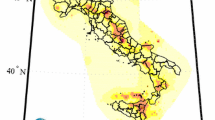Abstract
In this review we consider an interdisciplinary problem of earthquake prediction involving economics. This joint research aids in understanding the prediction problem as a whole and reveals additional requirements for seismostatistics. We formulate the problem as an optimal control problem: Prossessing the possibility to declare several types of alerts, it is necessary to find an optimal changing alert types; each successful prediction prevents a certain amount of losses; total expected losses are integrated over the semi-infinite time interval. The discount factor is included in the model. Algorithmic and exact solutions are indicated.
This paper is based on the recent results byMolchan (1990, 1991, 1992).
Similar content being viewed by others
References
Aki, K. (1989),Ideal Probabilistic Earthquake Prediction, Tectonophys.169, 197–198.
Ellis, S. P. (1985),An Optimal Statistical Decision Rule for Calling Earthquake Alerts, Earthq. Pred. Res.3, 1–10.
Feng, De Yi, Jing Ping Gu, Ming Zhou Lin, Shao Xie Xu andHue Jun Yu (1985),Assessment of Earthquake Hazard by Simultaneous Use of the Statistical Method and the Method of Fuzzy Mathematics, Pure and Appl. Geophys.,126, 982–997.
Gusev, A. A. (1976),Indicator earthquakes and prediction InSeismicity and Deep Structure of Siberia and Far East (in Russian), (Nauka Novosibirsk 1976) pp. 241–247.
Howard, R. A.,Dynamic Programming and Markov Processes (New York 1960) 136 pp.
Hawkes, A. G. (1971),Spectra of Some Self-exciting and Mutually Exciting Point Processes, Biometrica58, 83–90.
Kagan, Y. (1973),On a Probabilistic Description of the Seismic Regime, Fizika Zemli4, 110–123.
Kagan, Y. Y., andJackson, D. D. (1991),Seismic Gap Hypothesis: Ten Years After, J. Geophys. Res.96, 21419–21431.
Kantorovich, L. V., andKeilis-Borok, V. I.,Economics of Earthquake Prediction, Proceedings of UNESCO Conference on Seismic Risk, Paris, 1977.
Keilis-Borok, V. I., andRotwain, I. M. (1990),Diagnosis of Time of Increased Proability of Strong Earthquakes in Different Regions of the World: Algorithm CN, Phys. Earth and Planet. Inter.61, 57–72.
Keilis-Borok, V. I., andKossobokov, V. G. (1990),Premonitory Activation of Earthquake Flow: Algorithm M8, Phys. Earth and Planet. Inter.61, 73–83.
Khokhlov, A. V., andKossobokov, V. G. (1992),Seismic Flux and Major Earthquakes in the Northwestern Pacific (in Russian), Doklady RAN, 325, No. 1, 60–63.
Lindgren, G. (1985),Optimal Prediction of Level Crossing in Gaussian Processes and Sequences, Ann. Probab.13, 804–824.
Molchan, G. M. (1990),Strategies in Strong Earthquake Prediction, Phys. Earth and Planet. Inter.61, 84–98.
Molchan, G. M. (1991),Structure of Optimal Strategies of Earthquake Prediction, Tectonophys.193, 267–276.
Molchan, G. M.,Models for optimization of earthquake prediction (in Russian). InProblems in Earthquake Prediction and Interpretation of Seismological Data (Vychislitelnaya Seismologiya25) (Nauka, Moscow 1992) pp. 7–28.
Molchan, G. M., andKagan, Y. Y. (1992),Earthquake Prediction and its Optimization, J. Geophys. Res.97, 4823–4838.
Narkunskaya, R. S., andShnirman, M. G.,On an algorithm of earthquake prediction. InComputational Seismology and Geodynamics, 22/23 (English Transl.) (Am. Geophys. Union 1993).
Nishenko, S. P. (1989),Circum-Pacific Earthquake Potential: 1989–1999, USGS, Open File Report 89-86, 126 pp.
Ross, M.,Applied Probability Models with Optimization Applications (San Francisco 1970) 198 pp.
Ogata, Y. (1988),Statistical Models for Earthquake Occurrences and Residual Analysis for Point Processes, J. Am. Statist. Assoc.83 (401), Applications, 9–26.
Sadovsky, M. A. (ed.),Long-term Earthquake Prediction Methodology (in Russian), (Nauka, Moscow 1986), 128 pp.
Sobolev, G. A., Chelidze, T. L., Zavyalov, A. D., Slavina, L. B., andNicoladze, V. E. (1991),Maps of Expected Earthquakes Based on Cobmination of Parameters, Tectonophys.193, 255–265.
Vere-Jones, D. (1978),Earthquake Prediction—A Statistician's View, J. Phys. Earth.26, 129–146.
Working Group on California Earthquake Probabilities (1988),Proababilities of Large Earthquakes Occurring in California on the San Andreas Fault, U.S. Geol. Surv. Open File Rep. 88-398, 66 pp.
Author information
Authors and Affiliations
Rights and permissions
About this article
Cite this article
Molchan, G.M. Earthquake prediction as a decision-making problem. PAGEOPH 149, 233–247 (1997). https://doi.org/10.1007/BF00945169
Issue Date:
DOI: https://doi.org/10.1007/BF00945169




